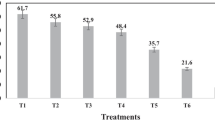Abstract
In this study, it was aimed for effective utilization of paper mill sludge through vermicomposting by varying seed proportion with sp. Eisenia fetida. Nine plastic trays were used for the experimental work including control. Different seed proportions of cow dung and cattle dung were tested. The multiplication of earthworms in terms of number was counted at the end of vermicomposting. The N, K, Ca, Na values of the manure in each vermibin were estimated before and after vermicomposting. In this study, it was concluded that tray A2 which has combination of 75% Cow dung (CD) and 25% Paper Mill Sludge (PMS) provided better nitrogen synthesis and lowering C/N ratio, whereas tray A4 (25%CD + 75% PMS) yielded better Calcium recovery. Both the seed materials were found to be suitable for Potassium recovery. From this study, it was inferred that vermicomposting of paper mill sludge with sp. Eisenia fetida along with seed materials can also solve the problem of disposal of this sludge.


Similar content being viewed by others
References
A. Kaur, J. Singh, A.P. Vig, S.S. Dhaliwal, P.J. Rup, Co-composting with and without Eisenia fetida for conversion of toxic paper mill sludge to a soil conditioner. Bioresour. Technol. 101, 8192–8198 (2010)
G. Thompson, J. Swain, C.F. Forster, The treatment of pulp and paper mill effluent: a review. Bioresour. Technol. 77, 275–286 (2001)
C. Kunzler, Pulp and paper industry’s diverse organics stream. Biocycle 42, 30–33 (2001)
S. Umamaheswari, V. Vijayalakshmi, N. Anbu, Saravanan (2012) Bioconversion of paper mill sludge employing the earthworm Eudrilus Eugeniae and its impact on the growth of Abelmoschus Esculentus. Int. J. Genet. Eng. Biotech. 3(2), 39–52 (2012). (ISSN 0974-3073)
R. Sharma, D. Sharma, K.S. Roa, R.C. Jain, Experimental studies on waste paper pulp biodegradation. Indian J. Environ. Health 44, 181–188 (2002)
C. Elvira, L. Sampedro, E. Benitez, R. Nogales, Vermicomposting of sludges from paper mill and dairy industries with Eisenia andrei: a pilot scale study. Bioresour. Technol. 63, 205–211 (1998)
S. Suthar, Recycling of agro-industrial sludge through vermitechnology. Ecol. Eng. 36, 1028–1036 (2010)
R.K. Sinha, S. Agarwal, K. Chauhan, V. Chandran, B.K. Soni, Vermiculture technology: reviving the dreams of sir charles darwin for scientific use of earthworms in sustainable development programs. Technol. Invest. 3(1), 155–172 (2010)
S. Suthar, S. Singh, Comparison of some novel polyculture and traditional monoculture vermicomposting reactors to decompose organic wastes. Ecol. Eng. 33, 210–219 (2008)
R.J. Banu, I.T. Yeom, N. Esakkiraj, Y.W.Lee Kumar, S. Vallinayagam, Biomanagement of sago-sludge using an earthworm, Lampito mauritii. J. Environ. Biol. 29, 753–757 (2008)
D. Dheepa, A. Subash, R. Parvatham, Selected physicochemical and microbiological analysis of vermicomposted lime and chrome sludge wastes from tannery industry. J. Ind. Pollut. Control 22(2), 341–344 (2006)
V.K. Garg, P. Kaushik, N. Dilbaghi, Vermiconversion of wastewater sludge from textile mill mixed with anaerobically digested biogas plant slurry employing Eisenia foetida. Ecotoxicol. Environ. Saf. 65(3), 412–419 (2006)
S. Zhang, S. Wang, X. Shan, H. Mu, Influences of lignin from paper mill sludge on soil properties and metal accumulation in wheat. Biol. Fertil. Soils 40, 237–242 (2004)
M. Benito, A. Masaguer, A. Moliner, N. Arrigo, R.M. Palma, Chemical and microbiological parameters for the characterization of the stability and maturity of pruning waste compost. Biol. Fertil. Soils 37, 184–189 (2003)
J. Dominguez, State-of-the art and new perspectives on vermicomposting research, Earthworm ecology, 2nd edn. (CRC Press, Boca Raton, 2004), pp. 401–424
V.K. Garg, P. Kaushik, Vermistabilisation of textile mill sludge spiked with poultry droppings by an epigeic earthworm Eisenia foetida. Bioresour. Technol. 96, 1063–1071 (2005)
G. Nath, U.K. Deb, Vermicomposting: an effective technique for paper mill solid waste utilisation and value addition. IPPTA: Q. J. Indian Pulp Paper Tech. Assoc. 20(2), 127–135 (2008)
D.W. Nelson, L.E. Sommers, Total carbon and organic carbon and organic matter, in Method of soil analysis, ed. by A.L. Page, R.H. Miller, D.R. Keeney (American Society of Agronomy, Madison, 1982), pp. 539–579
M.L. Jackson, Soil Chemical Analysis (Prentice Hall of India, New Delhi, 1975)
G. Tripathi, P. Bhardwaj, Comparative studies on biomass production, life cycles and composting efficiency of Eis-enia fetida(savigny) and lampito mauritii(kinberg). Bioresour. Technol. 92(3), 275–283 (2004)
T.C. Loh, Y.C. Lee, J.B. Liang, D. Tan, Vermicompost-ing of cattle and goat manures by Eisenia foetida and their growth and reproduction performance. Bioresour. Technol. 96(1), 111–114 (2005)
C. Tognettei, M.J. Mazzarino, F. Loas, Cocomposting biosolids and municipal organic waste: effects of peocess management on stabilization and quality. Biol. Fertil. Soils 43, 387–397 (2007)
S. Jiwan Singh, Ajay kalamdhad, Assessment of bioavailability and leachability of heavy metals during rotary drum composting of green waste (water hyacinth). Ecol. Eng. 52, 59–69 (2013)
R. Rynk, On Farm Composting Handbook (Northeast Regional Agricultural Engineering Service (NRAES-54), Newyork, 1992), p. 54
A.P. Vig, J. Singh, S.H. Wani, S.S. Dhaliwal, Vermicomposting of tannery sludge mixed with cattle dung into valuable manure using earthworm Eisenia fetita (Savigny). Bioresour. Technol. 102, 7941–7945 (2011)
C. Elvira, L. Sampedro, J. Dominguez, S. Mato, vermicomposting of wastewater sludge from paper-pulp industry with nitrogen rich materials. Soil Boil. Biochem 29, 759–762 (1997)
F. Fornes, D. Mendoza-Hernandez, R. Garcia-de-la-Fuente, M. Abad, R.M. Belda, Composting versus vermicomposting :a comparative study of organic matter evolution through straight and combined processes. Bioresour. Technol. 118, 1057–1061 (2012)
A. Yadav, V.K. Garg, Feasibility of nutrient recovery from industrial sludge by vermicomposting technology. J. Hazard. Mater. 168, 262–268 (2009)
Acknowledgement
Author would like to thank stalwarts who gave me valuable comment to improve the quality of manuscript and the author would also extend his thanks research scholars who helped me in conducting laboratory procedure for parameter analysis. Outlay of this work was entirely born by the author.
Author information
Authors and Affiliations
Corresponding author
Rights and permissions
About this article
Cite this article
Mohan, S.M. Vermicomposting of Paper Mill Sludge with Eisenia fetida for its Conversion to Nutrient Using Different Seed Materials. J. Inst. Eng. India Ser. A 98, 545–553 (2017). https://doi.org/10.1007/s40030-017-0253-8
Received:
Accepted:
Published:
Issue Date:
DOI: https://doi.org/10.1007/s40030-017-0253-8



